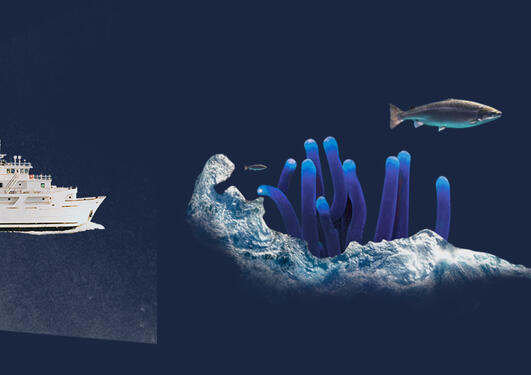Research possibilities for the SEAS postdoctoral research fellow in topological and geometric machine learning for marine sustainability
The information on this page is a supplement to the complete advertisement of the position in the recruitment-portal Jobbnorge. The full advertisement of this position in Jobbnorge will be available after august 1, and linked from this webpage. Call deadline is October 31, 2021.
Main content
Position | SEAS postdoctoral research fellow at Department of informatics |
Research area | Topological and geometric machine learning for marine sustainability |
Supervisor | Associate Professor Nello Blaser |
Mobility | For an incoming or outgoing candidate |
Unit of employment | Department of informatics at University of Bergen |
Group affiliation(s) | Machine Learning group/Center for Data Science |
Thematic area and supervisor
This position is connected to geometric and topological machine learning, the area of machine learning concerned with extracting and exploiting robust geometric information for the analysis of complex data. The position is open to either an incoming or an outgoing candidate, see mobility rules. The successful candidate will be employed at the Department of Informatics and included in the research group on machine learning and the Center for Data Science. Information about the supervisor, research groups and research possibilities for the fellow is available below. For further details about the research possibilities please contact Associate Professor Nello Blaser.
Research possibilities and resources
Nello Blaser is an associate professor in the Machine Learning group and the Center for Data Science at the Department of Informatics, University of Bergen. The Department of Informatics is a leading computer science department in Norway and has access to excellent researchers and computing resources. This project is tightly connected to Center for Data Science at the University of Bergen, an interdisciplinary center across several faculties focusing on research and education in central aspects of data science and artificial intelligence. In addition, a hired postdoc may be associated with the Bergen Applied Topology Group, consisting of researchers from the Department of Informatics and the Department of Mathematics at the University of Bergen. The Bergen Applied Topology Group was formed in 2016 and has since established fruitful collaborations with professor Ulrich Bauer at the Technical University of Munich, associate professor Magnus Bakke Botnan at Vrije University in Amsterdam and Senior Scientist Michael Aupetit at the Qatar Computing Research Institute.
Blaser’s research interests are focused on topological and geometric methods in statistics and machine learning. Topology and geometry are concerned with global and local structures, respectively. In machine learning, they have an important part in manifold learning (e.g., umap), network analysis (e.g., graph neural networks), multi-scale analysis (e.g., persistent homology), and feature engineering (e.g., persistence landscapes). Topological and geometric methods for deep learning have shown promise for regularization, interpretability, and improved performance on small data sets. Some important strengths of topological and geometric machine learning are their sparse representations and their ability to capture multi-scale behavior.
On the theoretical side, Blaser is interested in validation measures for topological methods, probabilistic topological and geometric methods, and algorithms for computing topological features. He has substantial work on approximating persistent homology [1-4], relative persistent homology [5], homology localization [6] and validation of mapper and generative Gaussian graphs [7].
Topological and geometric machine learning methods have also found great success in domains ranging from network science to material sciences, visualization, neuroscience, and time series analysis. In his applied works, Blaser addressed several topics relevant to marine sustainability, namely monitoring marine gas discharges [8-10], analysis of ensemble weather models [11] and fish toxicology [12-13]. From these projects, Blaser has a large network of collaborators in the Department of Mathematics, Department of Earth Science, and Department of Biological Sciences, and potential co-supervisors may come from any of these departments. Blaser also has an ongoing industry collaboration with Mohn Technology on machine learning applications for fish monitoring.
[1] Blaser, N., Brun, M., “Divisive Cover”. Mathematics in Computer Science (2019).
[2] Brun, M., Blaser, N., “Sparse Dowker nerves”. Journal of Applied and Computational Topology (2019).
[3] Blaser, N., Brun, M., “Sparse Filtered Nerves”. arXiv:1810.02149. (2020).
[4] Blaser, N., Brun, M., “Sparse Nerves in Practice”. Machine Learning and Knowledge Extraction (2019).
[5] Blaser, N., Brun, M., “Relative Persistent Homology”. In: 36th International Symposium on Com-putational Geometry (SoCG 2020).
[6] Blaser, N., Vågset, E. R., “Homology Localization Through the Looking-Glass of Parameterized Complexity Theory”. arXiv:2011.14490. (2020).
[7] Blaser, N., Aupetit, M., “Research Directions to Validate Topological Models of Multi-Dimensional Data”. NeurIPS 2020 Workshop on Topological Data Analysis and Beyond (2020).
[8] Gundersen, K., Oleynik, A., Blaser, N., Alendal, G., “Semi-conditional variational auto-encoder for flow reconstruction and uncertainty quantification from limited observations”. Physics of Fluids (2021).
[9] Gundersen, K., Alendal, G., Oleynik, A., Blaser, N., “Binary Time Series Classification with Bayesian Convolutional Neural Networks When Monitoring for Marine Gas Discharges”. Algorithms (2020).
[10] Oleynik, A., et al. “Optimal sensors placement for detecting CO2 discharges from unknown locations on the seafloor”. International Journal of Greenhouse Gas Control (2020).
[11] Galmiche, N., et al. “Revealing Multimodality in Ensemble Weather Prediction”. To appear ta MLVis (2021).
[12] Dale, K., et al. “Contaminant accumulation and biological responses in Atlantic cod (Gadus morhua) caged at a capped waste disposal site in Kollevåg, Western Norway”. Marine Environmental Research (2019).
[13] Yadetie, F. et al. “RNA-Seq analysis of transcriptome responses in Atlanticcod (Gadus morhua) precision-cut liver slices exposed to benzo[a]pyrene and 17-α-ethynylestradiol”. Aquatic Toxicology (2018).
See the full advertisement in Jobbnorge
The full advertisement in Jobbnorge will be available after august 1, 2021. Call deadline is October 31, 2021.
